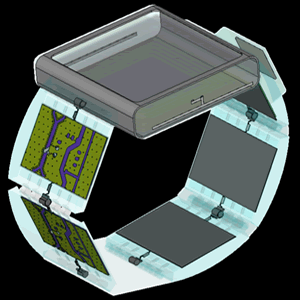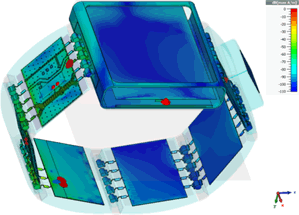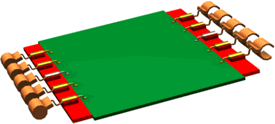Even watch bands may get smarter
Circuit board modules used for watch band concept

Dassault Systemes and Antenna Magnus simulated a watchband made of intelligent segments
The ability to cram more powerful electronics into smaller spaces has made portable equipment a pace-setting field for the electronics industry. Smartphones have become the flag bearer for this movement, but smart watches are rapidly ramping up the competition.
Early generation watches were fairly large, so there’s a push to create smaller watch bodies. That trend is offset by never-ending consumer demand for more functionality, which requires more semiconductors.
At DesignCon in Santa Clara earlier this month, representatives from two Dassault Systemes groups, Simulia and CST of America, teamed up with Antenna Magus to describe a concept that uses the watch band as a platform for additional electronics. The presentation, Signal Integrity and Electromagnetic Interference Modeling of a Smartwatch Wearable Device using Structural and Electromagnetic Co-design Methodologies, stressed the importance of the connectors that link the band segment and the watch together.
Designing a strap comprised of functional modules that are reconfigurable will let smartwatch users add new functionality by inserting strap modules that perform a specific task. The team simulated a system that includes multiple antennas, e.g., Wi-Fi, Bluetooth, GPS, and GSM/Cellular to achieve wireless connectivity, not to mention a timepiece and other features.
A critical aspect of the design was a low voltage differential signaling (LVDS) connector. One factor is providing the reliability needed for electronics that can undergo vibration and a number of drops. The proposed watch body has dimensions of 40x40x8 mm and the watch circumference (total length including the watch body, five interchangeable strap modules and an adjustable length clasp) is about 220 mm. The body of the watch is designed to be constructed using aluminum, with a touchscreen on the front. Each interchangeable strap module uses a polycarbonate outer casing and may contain electronic components along with a LVDS channel for communication.
The simulation also focused on signal integrity for the connector as well as the RF performance of integrated Wi-Fi, GPS, and GSM/Cellular antennas. RF interference between the digital interface and antennas was investigated along with EMI mitigation techniques to meet compliance all while achieving mechanical reliability.

Watch band modules each have a controller and LVDS connectors.
The mechanical design of connectors to enable insertion and removal of modules is evaluated in conjunction with any effects it may have on the signal integrity of data communicated through the connectors. The data communication in each strap module is handled by a separate controller IC, which processes the data that is gathered in the particular module from sensor, antennas, and peripherals and communicates this information to the main watch CPU.

Five contacts are used on either side of the band modules.
The electrical connectivity between the strap modules and the main body is achieved through the mating of female and male contacts on either end of the strap module, as shown in the image to the right.
There are five pins to allow five different power or data connections. The diameter of the contacting regions are gradually tapered down to allow for easier insertion of strap modules. In the fully engaged state, sufficient contact is established at the connector interfaces preventing the modules from sliding out freely or with small amount of forces. Mechanical simulations help with determining the amount of contact pressure induced based on the choice of geometrical parameters of the modules to strike a balance between providing sustained contact for electrical connectivity and comfortable way of connecting the modules without having to apply large amounts of force.
The initial design of the inter-module connector consists of five metal contacts. Since two contacts are needed for power and ground nets, respectively, this only leaves room for one differential channel without increasing the pin count in the connector. Consequently, the team decided to provide connectivity using LVDS, since it offers a high bandwidth through a single differential pair at a low power consumption. An LVDS Transmitter drives a 3.5mA current through a termination resistor at the receiver side. The transmitter is integrated on the PCB inside the strap module. The polarity of the voltage is detected by the receiver. The transmission channel consists of the connector and the traces on the printed circuit board.
The team’s simulations showed that the actual connector, although highly inductive, does not have a large impact on the channel characteristics. Instead, the channel’s bandwidth is dominated by the module PCBs and the stubs that are formed by the transmission lines, if certain controllers are left inactive.
Two architectures were analyzed. The daisy chain configuration offers a higher flexibility at the cost of more expensive integrated circuits and higher power consumption. The bus configuration, while cheaper and lower power, results in a lower flexibility.

Recently posted:
[related_posts limit=”10″]
- State of the Industry: 2022-2023 Connector Sales - April 16, 2024
- Amphenol is On a Roll - April 2, 2024
- Nicomatic Proves That Two Heads are Better Than One - March 26, 2024





